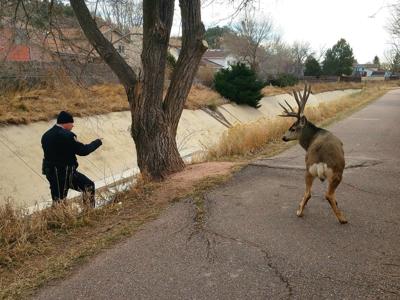Lacking a clear-cut solution to Colorado Springs’ exploding deer population, the City Council has hit the pause on discussions about allowing hunting within the city.
Instead, a recently passed law prohibiting the feeding of wild animals in town will have to do for the next few years while city officials look into how to deal with the overpopulation, Councilman Don Knight said.
“The appetite just wasn’t there, even on council,” Knight said of urban hunting.
City officials met with state and local experts for more than a year to discuss urban hunting, trapping, sterilization and other methods to control Colorado Springs’ deer population. Council members had hoped to find and implement a solution before September, when deer begin their most active season.
Deer in southwest Colorado Springs are estimated at 20 per square mile, well above the two or three deer typically found in healthy rural areas elsewhere in the state. Overpopulation can lead to an outbreak of disease among the animals, raises the number of animals struck by vehicles, damages the environment and private property and, in extreme cases, mass starvation for the deer.
The deer population in the city has reached its biological carrying capacity, said Frank McGee, area wildlife manager for state Parks and Wildlife.
“That’s where the number of deer in the landscape start negatively impacting the environment,” McGee said. “There are places in town where you can see pretty distinct browse lines, where everything that grows on a tree or a bush that a deer can reach has been eaten.”
A tightly regulated urban hunting program, involving bows and arrows instead of firearms, was thought to be the most effective and financially viable option to reduce the city’s deer population. Similar programs across the country have found varying degrees of success — the Air Force Academy has a successful deer hunting program that began in 1988.
Knight reiterated that the city would control who could particulate the hunt and when and where it would allowed. Despite that, there were worries about negative consequences.
One specific concern, Knight said, is that deer shot with arrows tend to continue moving and will often die a distance from where they were hit.
“The last thing we’d want to do is traumatize some little kid seeing a deer going down the street with blood pouring out of it,” Knight said.
Of the other options available, trapping and sterilization have proven to be relatively ineffective and expensive, McGee said. Realistically, the lethal options control herd sizes best.
Knight said the council wants more information before committing to a lethal option.
“We want to get a handle on the size of the herd and is it growing?” he said.
In addition, Knight said he wants more information on how healthy the population is.
About a deer a day is being killed by vehicles, according to city staff who have to retrieve the carcasses, Knight said.
Those deer can be tested for diseases after they’re cleared from the roadways.
While lethal options are tabled for now, the council isn’t stopping its efforts to curb the problem. Last month it approved a ban on feeding wildlife, including not just deer, but also bears, skunks, raccoons, wolves, coyotes, foxes, moose and antelope.
Violations of the new ordinance are noncriminal civil infractions and can result in a written warning. Citations can also be written and enforced by the city’s Code Enforcement Department.
Over the next two years, Knight said the city will continue to collect more data and discuss safe and effective ways to curtail the deer population.
In that time, experts can consider two additional factors, McGee said. The first is the city’s biological carrying capacity, which is the size a deer herd can reach before the animals begin starving to death, McGee said. And in an urban environment such as Colorado Springs, that point might never be reached.
The second is the social carrying capacity.
“What’s people’s willingness or tolerance to deal with wildlife?” McGee said. “How many collisions with vehicles is too many? How much property damage is too much? How do people feel about the number of deer and the conflicts they’re causing?”







(0) comments
Welcome to the discussion.
Log In
Keep it Clean. Please avoid obscene, vulgar, lewd, racist or sexually-oriented language.
PLEASE TURN OFF YOUR CAPS LOCK.
Don't Threaten. Threats of harming another person will not be tolerated.
Be Truthful. Don't knowingly lie about anyone or anything.
Be Nice. No racism, sexism or any sort of -ism that is degrading to another person.
Be Proactive. Use the 'Report' link on each comment to let us know of abusive posts.
Share with Us. We'd love to hear eyewitness accounts, the history behind an article.